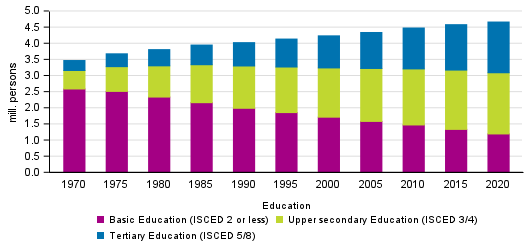Published: 3 November 2021
Share of population with educational qualifications has multiplied in 50 years
By the end of 2020, altogether 3,469,000 persons, or 74 per cent of the population aged 15 or over, had completed a qualification after basic level education. Fifty years earlier, 880,000 persons, or 25 per cent of the population, had completed a qualification.
Educational structure of population aged 15 or over in 1970 to 2020

Basic education includes persons, whose qualifications attained abroad are not known
Upper secondary education includes specialist vocational qualifications
The time series of the statistics on the educational structure of the population starts from 1970 when the basic data were collected in connection with the population census. In 1970, three-quarters of the population aged 15 or over had no upper secondary level qualifications and only 880,000 persons had completed a qualification. However, the level of education rose rapidly and in 1990 there were more persons with qualifications in the population than persons with only basic level education. The share of those with tertiary level degrees exceeded that of persons with only basic level education in 2015. In 2020, only good one quarter did not have qualifications after basic level education.
Population aged 30 to 39 by level of education indicator in 1970 to 2020

In the last 50 years, the post-basic level educational career of the population aged 30 to 39 has lengthened by 3.1 years. In 1970, the population had an average of one and a half years of post-basic level education, whereas in 2020 the corresponding figure was 4.6 years. The rise in the level of education continued in the 30 to 39 age group until 2013, when 4.6 years of education were also completed after basic level education. After this, the level of education expressed with the length of education has no longer risen but has actually started to decline. In 2018, the level of education rose by 0.1 years of education, which was the result of a one-off data collection used to gather data on qualifications completed outside Finland by persons with foreign background. In 2020, the highest educated age cohort were those aged 40 to 44, who had completed 4.9 years of post-basic level education.
The growth in the differences in education between the genders was visible among the population aged 30 to 39. Between 1970 and 1987, men completed more post-basic level education than women. From 1988 to 2020, women’s average length of education has grown by 2.1 years, while men’s average length of education has increased by only 1.1 years. In 2020, women completed an average of 5.1 years of education after basic level education, while the corresponding figure for men was 4.1.
Population with tertiary level qualifications, %, 2020

In 2020, the population with the highest education lived in Uusimaa, where 40 per cent of the population had completed a tertiary level qualification. The population with the second highest level of education lived in Pirkanmaa, where 34 per cent of the population had completed a tertiary level qualification. The share of highly educated people was lowest in South Ostrobothnia, Central Ostrobothnia, Kainuu and South Savo, where the share was only 26 per cent.
In 2020, there were 103,354 persons aged 20 to 29 with only basic level education, making up 16 per cent of the age group. Among men, 18 per cent of the age group had only basic level education and 13 per cent among women. The number of persons aged 20 to 29 with only basic level education was highest in ┼land, where 22 per cent of the age group had no post-comprehensive level qualification. The share of persons with only basic level education was lowest in North Karelia, where 12 per cent of those aged 20 to 29 had no qualifications after basic level education. Persons whose qualifications attained abroad are not known are also included in those without a basic level qualification.
Source: Education 2018. Statistics Finland
Inquiries: Mika Witting 029 551 3530, koulutustilastot@stat.fi
Head of Department in charge: Hannele Orjala
Publication in pdf-format (269.6 kB)
- Tables
-
Tables in databases
Pick the data you need into tables, view the data as graphs, or download the data for your use.
Appendix tables
Updated 3.11.2021
Official Statistics of Finland (OSF):
Educational structure of population [e-publication].
ISSN=2242-2919. 2020. Helsinki: Statistics Finland [referred: 19.4.2025].
Access method: http://stat.fi/til/vkour/2020/vkour_2020_2021-11-03_tie_001_en.html

